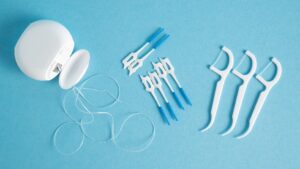
Dental implants continue to gain popularity as an ideal solution to restore missing teeth. Their unique placement in your jawbone provides advantages over alternatives like dentures and dental bridges. These prosthetics are the only ones that function as sturdy stand-alone structures in your mouth, making them much easier to maintain in the long run. Caring for them correctly is as easy as cleaning them twice daily and visiting your dentist every six months for a routine checkup.
However, because they’re built differently than your natural teeth, you must be careful not to damage your dental implants during your at-home dental hygiene routine. Continue reading to learn more about how to properly floss your replacement tooth to keep it happy and healthy!
Why Should I Floss My Dental Implants?
Dental implants consist of a titanium rod that’s surgically inserted into and eventually fuses with your jawbone. Once you’ve recovered from the procedure, your dentist attaches a dental crown, which is usually made from resilient porcelain. These materials don’t decay like your enamel, so it’s easy to assume that you don’t need to worry about brushing and flossing them.
Did you know, though, that peri-implantitis is one of the leading causes of failure? This is a particularly dangerous form of gum disease that can spread to your jawbone and weaken it to the point that it can no longer support your teeth. Flossing is essential for removing plaque and bacteria that can cause this underlying issue.
Why Can’t I Floss My Dental Implant Just Like My Teeth?
You should brush and floss your teeth twice daily, implant included, to minimize potential problems. However, your prosthetic isn’t held in place by a periodontal ligament like your natural teeth. Instead, it has a peri-implant seal that doesn’t contain the same nerves and won’t let you know if you’ve pushed too hard with your waxed string. If you’re overly aggressive, you could damage the seal and allow germs to access the site.
How Should I Floss My Dental Implant?
Remember to use caution when flowing around your restoration, and don’t push down into your gum pocket. Many patients purchase floss threaders to help get the string between their teeth. Once it’s in place, create a C-shape with the cord and move it around the base of your tooth. Gently rub it up and down the side of your implant and crown to remove any accumulations of plaque and bacteria.
If you’re overly anxious about inadvertently harming your new tooth during flossing, you can skip it for now and call your dentist to seek appropriate solutions.
About the Author
Dr. Koleini takes pride in providing families with top-quality, comprehensive dental services from one convenient location. He earned his dental degree from the Boston University School of Dental Medicine (BUSDM), where he graduated magna cum laude. Since then, he has committed 100+ hours to ongoing education in a variety of topics, like cosmetic dentistry and dental implants. He’s a valued member of the American Dental Association and other prestigious organizations, so you can trust that your grin is in good hands. If you’re considering dental implants, you can request a consultation on the website or call (978) 650-2793.
